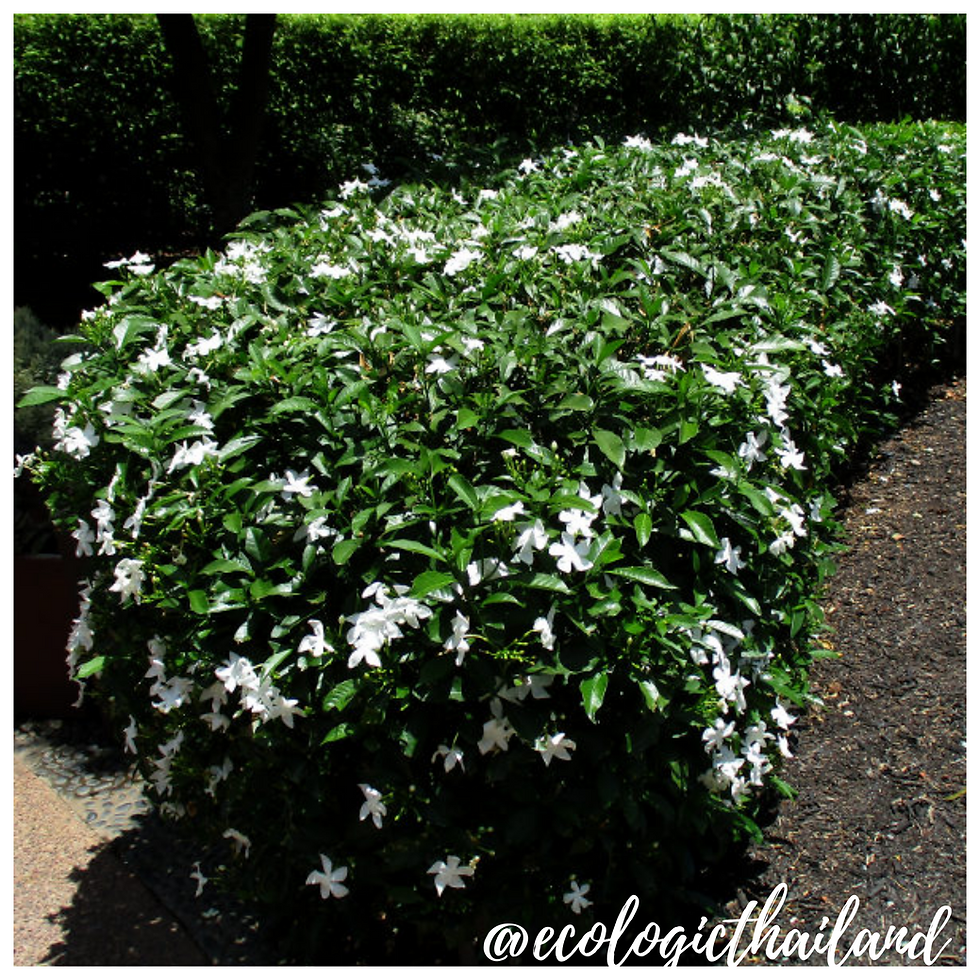Chayote squash | Vegetable pear
- Eco-Logic Resort
- Dec 20, 2020
- 3 min read
Fak maeo | ฟักแม้ว | Sechium edule
Family: Cucurbitaceae - Genus: Sechium

The Chayote squash can be found behind TCDF's Special School in the herbal garden.
Chayote is an edible plant belonging to the gourd family. Chayote is a gourd that is often referred to as a vegetable, but technically this bright, green pear-shaped food is a fruit.
It is a wide-spreading vine that can grow up to fifteen meters in length.
The entire chayote plant is edible, including the squash, flowers, vines, leaves, and roots, and Tropical chayote is a common ingredient in Asian cooking utilized to absorb accompanying flavors and add a crisp, fresh consistency into heavily spiced dishes.
Harvest in about 15-17 weeks after planting and can be harvested whole year round, but less in the rainy season.

THE VINE
The chayote vine can be grown on the ground, but as a climbing plant, it will grow onto anything, and can easily rise as high as 12 meters when support is provided.

THE LEAVES
Chayote leaves are small to medium in size and thin, broad, and heart-shaped, approximately 10-25 centimeters wide. The vibrant green leaves have a sandpaper-like texture and have 3-5 pointed lobes with small thin tendrils attached near or at the base of the stem.
Chayote leaves are crisp and juicy with a mild, sweet, and grassy flavor with mellow undertones of cucumber.

THE FLOWERS
The flowers grow in inflorescences with groups of male blooms and a single or pair of female blooms. The blossoms are small, white to light green and are not particularly noticeable. In fact, their inconspicuous nature could be one reason you don’t see any flowers on the chayote.

THE FRUIT
In the most common variety, the fruit is roughly pear-shaped, somewhat flattened and with coarse wrinkles, ranging from 10 to 20 cm in length. It looks like a green pear, and it has a thin, green skin fused with the green to white flesh, and a single, large, flattened pit.
Some varieties have spiny fruits. The flesh has a fairly bland taste, and a texture is described as a cross between a potato and a cucumber.
The fruit does not need to be peeled to be cooked or fried in slices. It has a very mild flavor. It is commonly served with seasonings or in a dish with other vegetables and flavorings. It can also be boiled, stuffed, mashed, baked, fried, or pickled

THE ROOTS
The tuberous part of the root is starchy and eaten like a yam (can be fried).
CULINARY USES
Fruit:
The chayote fruit is mostly used cooked. When cooked, chayote is usually handled like summer squash; it is generally lightly cooked to retain the crispy consistency.
Raw chayote may be added to salads, most often marinated with lemon or lime juice, but is often regarded as especially unpalatable and tough in texture it is sometimes used as a substitute for green papaya in som tam (click on the link of the Food Forest Kitchen for the recipe). As the squash matures, the skin is edible but is commonly removed as it bears a chewy, tough texture.
Tropical chayote is often added to soups, stews, curries, and casseroles, or it is finely chopped and used as a filling for dumplings. It can also be stir-fried or sautéed with other vegetables for an added crunchy element or stuffed and baked similarly to a potato. Fully mature Tropical chayote can be boiled and mashed or slow-roasted as an accompaniment to fried fish and white rice.
Root, stem, seeds and leaves:
Although most people are familiar only with the fruit as being edible, the root, stem, seeds and leaves are edible as well, and are popularly stir-fried or mixed into salads and soups
The tubers of the plant are eaten like potatoes and other root vegetables, while the shoots and leaves are often consumed in salads and stir fries.
NUTRITION
Both fruit and seed are rich in amino acids and vitamin C, which is an antioxidant that can help boost the immune system and is also a good source of vitamin B-6, folate, dietary fiber, folate, and potassium.
TRADITIONAL MEDICINAL
NOTE: please take advice from a doctor if you are planning to use herbal medicine.
The leaves and fruit have diuretic, cardiovascular and anti-inflammatory properties, and a tea made from the leaves has been used in the treatment of arteriosclerosis and hypertension, and to dissolve kidney stones.
Chayote is extremely rich in antioxidants, which is said to work to fight free radical damage, ultimately slowing the aging process by protecting cells. One of the primary antioxidants in chayote is vitamin C, which is necessary for collagen production.
INTO THE WILD: a down to earth experience

For guests and visitors to Paksong we organize weekly tours "The Edible Forest" and Foraging weekends: Into the Wild. We work with local guides to take you in the jungle of Paksong. After foraging, we will cook a meal with the ingredients, using bamboo together with you!
Come and join and learn about the abundance of food that nature gives us!
INTO THE WILD!


















Comments